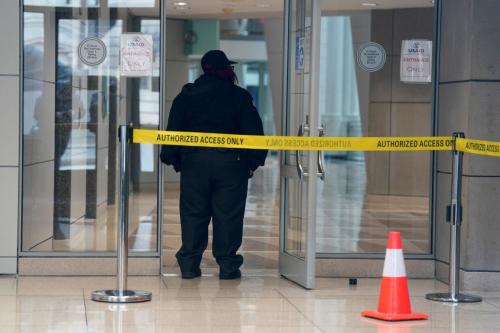When it comes to staying in school, many economists talk about the “aspirational effects” of income inequality. When students look around them and see a better life, they are incentivized to invest in their own human capital—such as investing in their own education.
But what if that conventional thinking is wrong? What if inequality doesn’t incentivize students at the bottom of the income ladder to work harder, but rather disincentivizes them? This is one of the questions Melissa S. Kearney and Phillip B. Levine sought to answer in a new paper published as part of the Spring 2016 Brookings Papers on Economic Activity.
Whether you study economic mobility, or simply believe in the principle of the American Dream, the paper has an important new finding you should be aware of:
low-income children who grow up in states with greater income inequality drop out of high school at higher rates than their peers living in states with less income inequality (that is, states with smaller gaps between the bottom of the income ladder and the rungs above).
Why is this happening? The authors point to a concept they call “economic despair,” or a feeling that economic success is unlikely because the distance from the bottom to the middle of the ladder is too far to climb. If a student perceives a lower benefit to remaining in school, then he or she will choose to drop out—even if they aren’t struggling academically.
To hear one of the authors explain the research in her own words, watch the video with Melissa Kearney below. You can also take a closer look at some of the data and findings by exploring these interactive charts.
Forget the top, how hard is it to get to the middle?
Though many like to focus on the gap between the top and the bottom of the income distribution, Kearney and Levine’s research puts a particular focus on income inequality in the lower half of the income distribution (as measured by income gaps between the 10th and 50th percentiles of the distribution).
This “lower-tail” inequality is more relevant, they suggest, because while making it from the bottom to the top of the distribution might seem out of reach to poorer youth, making it to the middle could be a more realistic ambition.
The link between inequality and reduced mobility
It’s often been assumed that income inequality might lead to less upward mobility. Kearney and Levine’s paper is one of the first to provide empirical evidence that there is a causal relationship—not merely a correlation—between inequality and mobility.
That, in turn, has important implications for social policy, as it suggests a need for interventions that focus on bolstering low-income students’ perceptions of what they can achieve in life.
The authors write: “Interventions might take the form of mentoring programs that connect youth with successful adult mentors and school and community programs that focus on establishing high expectations and providing pathways to graduation. They could also take the form of early-childhood parenting programs that work with parents to create more nurturing home environments to build self-esteem and engender positive behaviors.”
To learn more, read the full paper here by Melissa Kearney, Brookings nonresident senior fellow and University of Maryland economics professor, and Phillip Levine, a professor of economics at Wellesley.
The Brookings Institution is committed to quality, independence, and impact.
We are supported by a diverse array of funders. In line with our values and policies, each Brookings publication represents the sole views of its author(s).



Commentary
How “economic despair” affects high school graduation rates for America’s poorest students
March 10, 2016